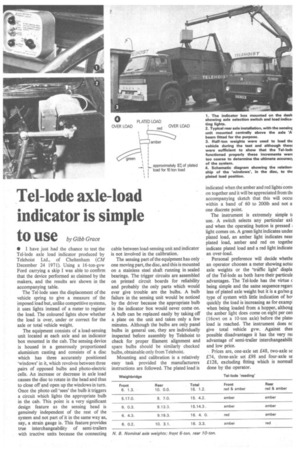Tel-lode axle-load indicator is simple
Page 22

If you've noticed an error in this article please click here to report it so we can fix it.
to use by Gibb Grace • I have just had the chance to test the Tel-lode axle load indicator produced by Telehoist Ltd., of Cheltenham (CM December 24 1971). Using a 16-ton-gvw Ford carrying a skip I was able to confirm that the device performed as claimed by the makers, and the results are shown in the accompanying table.
The Tel-lode uses the displacement of the vehicle spring to give a measure of the imposed load but, unlike competitive systems, it uses lights instead of a meter to register the load. The coloured lights show whether the load is over, under or correct for the axle or total vehicle weight.
The equipment consists of a load-sensing unit located at each axle and an indicator box mounted in the cab. The sensing device is housed in a generously proportioned aluminium casting and consists of a disc which has three accurately positioned 'windows' in it, which revolves between three pairs of opposed bulbs and photo-electric cells. An increase or decrease in axle load causes the disc to rotate in the head and thus to close off and open up the windows in turn. Once the photo cell 'sees' the bulb it triggers a circuit which lights the appropriate bulb in the cab. This point is a very significant design feature as the sensing head is genuinely independent of the rest of the system and not part of it in the same way as, say, a strain gauge is. This feature provides true interchangeability of semi-trailers with tractive units because the connecting
cable between load-sensing unit and indicator is not involved in the calibration.
The sensing part of the equipment has only one moving part, the disc, and this is mounted on a stainless steel shaft running in sealed bearings. The trigger circuits are assembled on printed circuit boards for reliability and probably the only parts which would ever give trouble are the bulbs. A bulb failure in the sensing unit would be noticed by the driver because the appropriate bulb in the indicator box would never come on. A bulb can be replaced easily by taking off a plate on the unit and takes only a few minutes. Although the bulbs are only panel bulbs in general use, they are individually inspected before assembly by Telehoist to check for proper filament alignment and spare bulbs should be similarly checked bulbs, obtainable only from Telehoist.
Mounting and calibration is a relatively easy task provided the manufacturers instructions are followed. The plated load is
indicated when the amber and red lights corn( on together and it will be appreciated from th( accompanying sketch that this will occtr within a band of 60 to 200lb and not a one discrete point.
The instrument is extremely simple ti use. A switch selects any particular axt and when the operating button is pressed , light comes on. A green light indicates under plated load, an amber light indicates near plated load, amber and red on togethe indicate plated load and a red light indicate an over-load.
Personal preference will decide whethe an operator chooses a meter showing acttu axle weights or the 'traffic light' displa of the Tel-lode as both have their particuls advantages. The Tel-lode has the virtue c being simple and the same sequence regarc less of plated axle weight but it is a go/no g type of system with little indication of ho, quickly the load is increasing as for ex amp when being loaded from a hopper, althoug the amber light does come on eight per cen (16cwt on a 10-ton axle) before the plate• load is reached. The instrument does nc give total vehicle gvw. Against thes possible disadvantages it has the very rer advantage of semi-trailer interchangeabilit and low price.
Prices are, one-axle set £48, two-axle se £74, three-axle set £98 and four-axle se £128, excluding fitting which is normal] done by the operator.
























































































